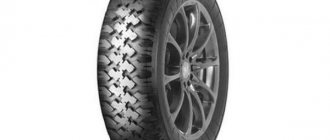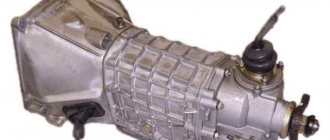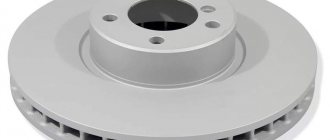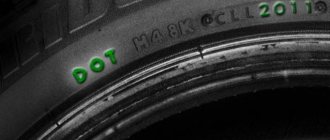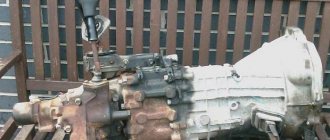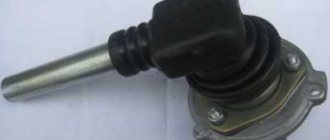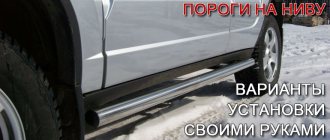What does the size of tires and wheels affect?
| Increasing disc diameter | Increasing rim width | Increasing tire width | |
| Car style | will improve | will improve | will improve |
| Road holding | will improve | will improve | will improve |
| Steering precision | will improve | will improve | will improve |
| Tire grip | Will not change | Will not change | will improve, but only on dry roads |
| Resistance to hydroplaning | Will not change | Will not change | will get worse |
| Comfort on rough roads | will get worse | Will not change | will improve |
| Road noise | Will not change | Will not change | will intensify |
| Gasoline consumption | Will not change | will increase | will increase |
| Tire wear | Will not change | Will not change | will increase |
The smaller the unsprung mass (this includes the mass of tires and wheels), the better the car will hold the road and accelerate faster.
For example, if you put wheels on a car that are 2 kg lighter each, then acceleration to 100 km/h will be reduced by 0.2 seconds. You can buy rims for Lada 4×4 at the lowest prices from us.
As a reminder, for safety and to increase tire life, you should maintain your tires at the recommended pressure. Other modifications to the Lada 4×4 can be found in the tuning category and by content.
Keywords: 4x4 wheels | 4x4 tires | Lada 4x4 urban
52 7
Found an error? Select it and press Ctrl Enter..
- LADA car sales statistics in June 2020
- Video crash test Lada Granta sedan
- What kind of gearbox is used on Lada Granta, Kalina, Priora
- Test drive Lada Kalina NFR from Anton Avtoman
Allowable wheel size for the field
| Tire size with load capacity and speed indexes* |
* Speed indices: Q – up to 160 km/h, S – up to 180 km/h, T – up to 190 km/h.
Load capacity indices: 85 – 515 kg, 88 – 560 kg, 92 – 630 kg, 95 – 690 kg. **Rim offset (ET) is the distance from the mating plane of the disc to the middle of the rim.
*** In operation, it is allowed to install wheels with a rim width of 5½ J and a rim offset of 48 – 58 mm. It is allowed to use winter tires (M+S) of the above dimensions and index Q with a corresponding limitation of the maximum vehicle speed (up to 160 km/h).
Standard wheels for the Urban package
| Wheel size | Air pressure in tires, MPa (kgf/cm2) | |||
| rim width | rim offset, (ET)**, mm | front wheels | rear wheels | |
| Installed by the manufacturer (standard) | ||||
| 185/75 R16 92Q 95T | 5J*** | 58 *** | 0,21 (2,1) | 0,19 (1,9) |
| Allowed to be installed in operation | ||||
| 175/80 R16 88Q | 5J, 5½J | 48-58 | 0,21 (2,1) | 0,19 (1,9) |
| 195/70R15 92Q, T | 5½J, 6J | 45 | 0,19 (1,9) | |
| 205/70R15 95Q, S, T | 6J, 6½J | 40 | 0,19 (1,9) | |
| Tire size with load capacity and speed indexes* | Wheel size | Tire air pressure. MPa (kgf/cm2) | ||
| rim width | rim offset, (ET)**; mm | front wheels | rear wheels | |
| Main wheel with cast disc | ||||
| 185/75 R16 92Q95T | 6Jx16H2 | 40 or 58 | 0,21 (2,1) | 0,19(1,9) |
| Spare tire for temporary use (stamp) | ||||
| 185/75 R16 92Q95T | 5J | 58 | 0,21 (2,1) | 0,19(1,9) |
WHEEL MOUNTING (wheel nut size)
| Wheel fastening | Thread | Nut height, mm | Hexagon size of the wrench nut head, mm | Nut strength class, not less | Wheel tightening torque, Nm |
| Nut (stamp-welded wheel) | M12×1.25 | 16+0,77-0,5 | 19 | 6 | 95±5 |
| Nut with spanner stop (stamp welded wheel, cast wheel) | 17+0,7/-0,5 | ||||
| The nut is closed, with a key stop (stamp-welded wheel, cast wheel) | 23,7+0,7/-0,5 |
Which wheels are better to install on Lada 4×4
The choice of tires for R16 wheels is not large; most often they choose sizes 185/75 R16, 175/80 R16, or 215/65 R16. Due to the paucity of choice, many SUV owners install R15 wheels on their Lada 4×4.
R15 wheels can be borrowed from Chevrolet Niva wheels, which fit without modifications. Thus, the choice of tires will increase significantly and you will be able to choose the appropriate tires for certain operating conditions. In addition, a car with such wheels will look more stylish.
Do you dream of a Lada 4×4 with big wheels, but don’t want to cut the arches? The maximum tire size for a Lada 4×4 without modifications is 215/75 R15, and the rims must have an offset of 40, otherwise the tires will touch the fender liners. Finally, install alloy wheels on your Lada 4×4 and you will get a stylish SUV!
And also interesting: Front and rear suspension of the VAZ 2114: do-it-yourself installation and repair || Niva 2113 suspension
When choosing wheels, you should take into account the full diameter of the wheel; it should not differ much from the standard one. Compatibility table for Lada 4×4 tires and wheels:
The green color indicates the minimum deviation of the wheel diameter (up to 3 mm); Orange indicates a diameter deviation from 3 to 6 mm.
Don't forget about the rim width:
When installing tires or wheels that differ in parameters from those recommended by the factory, you can:
- be refused warranty repair of the chassis;
- be stopped by a traffic police inspector, who has the right to draw up a report on the car’s non-compliance with the requirements of the Technical Regulations;
- fail to pass technical inspection.
Selecting disks for Niva
To choose them correctly, you should assume what the operating conditions will be. Some people use their cars to overcome mud; for others, wheels are primarily an aesthetically attractive attribute, while practicality is far from being in the first place. Having taken the wheels, you should also select tires suitable for them.
Standard sizes
First, you should carefully examine the factory wheels of the Niva, examining the inscriptions in more detail. So, standard wheels on Niva have the following characteristics: 5J x 16, H2-ET = 58, DIA = 98, PCD = 5 x 139, 7. Based on this, you need to choose alternative wheels with the same parameters. Minimal deviation up or down is allowed.
For a better understanding, you need to decipher all these symbols.
- 5J. This parameter means that the manufacturer allows the installation of tires no larger than 5 inches. A maximum of 1 inch deviation is allowed. The Latin letter J indicates that the installed tire has only one side.
- R16. The number means that the diameter of the rim and tire is 16 inches.
- H2. Structurally, the wheel has a rim with two khanty (rings along the edges of the rim). Hunts serve to tightly fix the tubeless tire on the rim while driving; these elements are also mandatory for SUVs.
- ET. Wheel offset designation, internal deviation of no more than 1 cm is allowed. The smaller the wheel offset value, the greater the distance between them.
- DIA. The value of the wheel hub diameter in millimeters (radius).
- PCD. The number of holes for mounting bolts and the distance between them. In other words, a loose talk.
In addition to conventional stamped wheels of standard size, the best alternative option is standard Chevrolet Niva wheels and wheels made of light alloy materials. They are perfect in all respects.
Tires for even greater cross-country ability: 235/75 r15 and 240/80 r15
For those for whom standard cross-country ability is not enough and want to go into the real wilds, then you just need to take R15 tires with this dimension (235/75) and put it in the Niva. These dimensions will make the car a real jeep, which will essentially go everywhere it can go. So whoever has such goals should put such wheels on the Niva.
But it’s not so simple, in order for such tires to become normal, you will have to do a lifting, this is a kind of tuning of the Niva. You'll have to raise the suspension and widen the wheel arches. But this is not a problem at all, because even at the plant in Togliatti there are special lifting kits, thanks to which the wheel axle can be made lower by 4 cm, which will be enough to install such off-road tires R15 235/75.
Also interesting: Which tires to choose for Niva in winter
The lifting kit includes:
- cross rod,
- upgraded spring cups;
- spring spacers;
- reinforced longitudinal rods;
- spacers for the ball joint.
If you install this kit correctly, the shock absorbers and springs will fit as they should. But that’s not all, for a full ride you still need to make some changes: change the pairs of front and rear gearboxes. If they come from the factory 3.9, then you need to put 4.44. The result will be increased acceleration dynamics, and there will be less load on the engine and clutch.
You also need to remember that there is also an offset of the wheel rims, this parameter needs to be increased slightly, for this you need to make special spacers from aluminum alloy and install them in the hub. Masters usually know how to do this.
After such improvements, the hub assembly will operate under increased loads, so it is recommended to install hubs with 2-row bearings on the steering knuckle. This kind of Niva tuning will require a little time and money.
Standard wheels for the field
If you don’t do a lift, then the Niva will have standard arches, so only standard wheels with standard tires will fit here. Initially, the factory installs wheels with VLI-5 R16 175/80 tires. Basic tires are not a particularly good option; they have the following disadvantages:
- if the car drives on a hard road at a speed of more than 60 km/h, then the noise from the tires will be normally audible;
- in winter, rubber becomes less elastic;
- the base tires are tube tires, which can also be considered a disadvantage;
- Handling on a flat road leaves much to be desired.
Also interesting: Do-it-yourself improvements to the Niva 2121
But this tire also has its advantages: it rides well on wet off-road conditions, especially on clay. And the most important advantage is the low price of these tires for Niva. But for those who have the money and the desire to install more serious tires on the Niva, there are many interesting alternative options.
What tires should I put on the Niva?
The desire of the owners of domestic cars to somehow improve the discreet appearance of the car is ineradicable.
And it’s no wonder that the Niva, which looks like a modest worker on its “native” 16-inch narrow tires, is increasingly found with tires of a smaller mounting diameter - 14 and 15 inches, and they are trying to choose wider wheels. Indeed, a car with wide tires looks much more “militant” - a sort of Pajero “Zhiguli bottling”. How does the installation of wheels not provided by the factory affect the basic consumer qualities of the car, in particular, handling, comfort, and cross-country ability?
To answer these questions, we tested four sets of tires on the VAZ-21219 (remember that this is a transitional model from the 5AZ-2121 to the VAZ-21213, popularly known as Taiga). These are 16-inch road VLI-10 and off-road VLI-5 on “native” wheels, and also two “non-standard” options - NIISHP I-339 tires with a dimension of 195/70 R15 and “imported” Ukrainian tires Rosava 205/70 R14.
Of course, with this “tuning”, not only the appearance of the Niva has changed. Wheels with Volga 14-inch tires had to be installed with spacers - otherwise the disk would touch the steering knuckle. (Alloy wheels with a modified offset, made specifically for the Niva, fit much easier.)
But in any case, the running shoulder and the car's track increase, and this means an increased load on the hub bearings and axle shafts, and other suspension parts. And the wide wheel does not fit into its “rightful” place in the engine compartment, and it has to be placed in the trunk or on a special bracket at the back, like in “adult” jeeps. But, judging by the popularity of such modifications, this does not bother many Niva owners.
So which is better?
DRIVING ON ASPHALT
As always, we decided to dance from the stove - using the VLI-10 road tire as a starting point. On it, the Niva has a decent smooth ride and satisfactory noise - the transmission is mostly “audible”. When cornering, the Niva on the VLI-10 has almost neutral understeer. When you add gas, the car smoothly creeps outward, and when you release it, it spins into the turn with a slight skid.
At the limit, a well-controlled sliding occurs, and the turning radius can be changed within very wide limits, without spending a fair amount of effort on rotating the steering wheel, which is clearly not lightweight (in terms of effort), but only by “moonlighting” the accelerator pedal.
The diagonal rigid VLI-5 is noticeably “oakier” and noisier. The car vibrates, the howling of the tires drowns out all other noise, even at low speeds.
The handling characteristics remain approximately the same, but the force on the steering wheel increases somewhat, and the Niva turns into turns much less willingly than on the VLI-10. The car skids earlier and behaves somewhat “smeared” - this is due to the large slip of the diagonal tires. In a word, the “toothy” VLI-5 is not for asphalt.
We install a 15-inch NIISHP. The Niva immediately went noticeably more cheerfully, it became easier to move away and accelerate faster: the wheel diameter was smaller, and therefore the overall gear ratio increased. The NIISHP makes about the same noise as the VLI-10, but when driving over uneven surfaces, these tires are somewhat harsher than the VLI-10, although better than the VLI-5.
In corners, the Niva began to behave noticeably more confidently, and the nature of the understeer changed towards excessive, but not by much. In any case, not so much that the change can be called unpleasant, much less dangerous. And the steering wheel became a little lighter. Overall, the impression was very pleasant.
It's the turn of the 14-inch Rosava tires. From a standstill, the Niva “tears its own feet”! And the same responsive response to the accelerator pedal is maintained throughout almost the entire speed range. So from the point of view of “dynamism”, Rosava tires are perhaps the best.
But the wheels are clearly noisier than the previous ones, although, of course, noticeably quieter than the VLI-5. But the smoothness of the ride is excellent. The soft “Ukrainian” actually swallows both seams and small irregularities on the asphalt.
In terms of handling, the situation is repeated with 15-inch tires - the impression of very light steering of the rear axle. However, the force on the steering wheel increased noticeably and became approximately the same as with VLI-5 tires.
Summing up the “asphalt” impressions, we can safely give the palm to non-standard tires. For everyday city driving, in our opinion, the 15-inch NIISHP and (to a lesser extent) 14-inch Rosava are most suitable for the Niva. VLI-10 is a good option for a calm, economical driver, but the “rude and insensitive” VLI-5 is not at all appropriate on asphalt.
But Niva is also an SUV...
WE CLIMB INTO THE MUD
Fortunately, there is plenty of off-road driving in Russia - and we easily chose three routes with different conditions. One is a typical village road with muddy mud and deep ruts, where traction was assessed mainly. The second is loose sand dunes, where the so-called traction-support permeability is most fully manifested. And finally, we climbed along slopes and gullies to see how the so-called geometric cross-country ability changed depending on the diameter of the wheel.
We felt quite confident in the mud on the VLI-10, although the wheels often slipped. The difference was very noticeable when driving with a locked differential and without a lock. But when it came to slippery climbs... There is absolutely nothing to do here without blocking. It feels like these tires don’t help the Niva at all in such conditions. You can only rely on speed and confidently overcome obstacles on foot.
And the Niva often drives on slopes not in the direction you turn the steering wheel, but slides towards even a small incline. As a result, you have to turn the steering wheel too actively in the mud. The car completely refused to leave the wet rut. And no wonder, because there’s nothing to catch it on the ground; it’s a road tread, without lugs.
But VLI-10 behaves well in sand. True, here you already have to use a lower row of the transfer case, especially in “loose” conditions. The car moves rather heavily, with a slight slip, since you have to keep the speed at least 2000-2500 rpm. It should be noted that a slight slip of these tires is not terrible: the Niva does not bury itself in the sand. But if you “overdo it”, revving it with all your heart, then you can dig in.
On the “toothy” VLI-5 tires, the Niva went completely differently. You can feel that the developed tread pattern is working - it gives the car confidence in overcoming obstacles, and in handling on wet grass and in mud. In “medium-heavy” mud, there was practically no need to use a lock. In any case, we did not feel any difference in the confidence of progress.
True, on climbs, differential locking was still required. And the Niva gets out of a slippery rut on these tires quite confidently - the lugs help. True, there is one small “but”: under no circumstances should slippage be allowed! When driving in extreme conditions, this tire can be detrimental; it buries the car in such a way that it is no longer possible to get out without outside help.
The same thing, but “squared”, happens in the sand - thanks to the “milling” effect, the wheels are able to instantly bury the car up to its belly. After all, the same lugs that dig into the dirt and soil shovel sand almost instantly.
But the wide I-339 allows Niva to confidently move along the sand and even climb onto dunes. You have to use the lower row of the transfer case less often than with 16-inch tires, and the Niva starts off noticeably more confidently. But it became harder to turn the steering wheel.
But in mud, the advantages of wide tires come to naught - the road tread pattern takes its toll. The car behaves almost exactly the same as with the road VLI-10, and the car now “floats” in the mud more. But in general, there is approximately the same wheel slip and the same need to use a lock.
We install 14-inch Rosava muds. At first, the Niva walked through the mud a little more confidently than on the VLI-10. But in mud, the tread gets washed out very quickly, and the result is the same as on other “highway” roads. But on wet grass the car behaved much better. The tread pattern and the reduction in wheel radius clearly help here.
And in the sand, the Niva moves absolutely confidently on these soft tires - better than on the others. The impression is that the car seems to be floating on water on float wheels, and not driving on sand. No problems, as you'd expect. By the way, this is a general pattern: on sand, the Niva “likes” to ride on wide and soft tires, and the wider and softer the better.
And among the holes, ditches and hillocks, where we checked how the geometric cross-country ability of the Niva changed, on the VLI-10 and VLI-5 tires the Niva moved “like at home.” And of course, 15-, and especially 14-inch tires made her scrape her belly over the hillocks where we could easily drive even on the VLI-10. It’s good that the ground was quite soft - unevenness could be “cut off with your stomach”, increasing the pace of movement. But on dense ground or on rocks it will be difficult...
And in the deep ruts from the truck, the Niva moved confidently only on “its” 16-inch tires. Shod in I-339, and even more so in 14-inch Rosava tires, the Niva began to actively scrape the rear gearbox and the car was operated “a little bit everywhere.”
The VLI-5 tires turned out to be, as we expected, out of competition on dirty and broken roads and on slippery slopes. In general, in off-road driving, with the exception of sand. And they provide the best “geometry”. But on asphalt they are very noisy. It is better to equip a Niva with such tires for those owners who drive a lot off-road; they should not be driven on asphalt.
The use of 15- and 14-inch tires makes the car more dynamic, lighter and more enjoyable to drive on hard roads. Even more aggressive. But at the same time, the geometric parameters of the Niva noticeably deteriorate - and the car turns from a good “rogue” into an almost passenger all-wheel drive vehicle.
In our opinion, 15-inch wheels, such as NIISHP I-339, are most preferable for asphalt. This is the “golden mean” between dynamism and efficiency; moreover, the NIISHP I-339 turned out to be the best in terms of braking properties. The small 14-inch Rosava tires, although they provide better elasticity, are still very thirsty.
What to put on the Niva? It depends on where and how you use your machine. We tried to reflect our recommendations in diagrams of expert assessments, but it’s up to you to decide.
R15 tires with dimension 215/75
These tires fit into the Niva without any modifications at all, but only if the right disc is selected. The tires need to be 27-28 inches, and the offset should be 35-58 mm. But sometimes it is possible that the wheels will touch the fender liners, especially if:
- the car is heavily loaded;
- The car drives over strong bumps that the suspension reaches the extreme points of its travel.
But what advantages do you get when you put R15 215/75 tires on the Niva:
- cross-country ability becomes better;
- fuel consumption decreases;
- there is no need to do lifting.
With this dimension, you can choose tires from this list:
- Michelin Latitude X-ice North;
- Dunlop Grandtrek AT3;
- Cordiant Off Road;
- Yokohama Geolandar;
- Nokian Hakkapeliitta SUV 7;
- Kumho Road Venture.
Dunlop Grandtrek AT3 and Yokohama Geolandar are all-season tires that fit perfectly into the wheel arches of the Niva, and they also go well with the Niva suspension. Kumho and Cordiant are off-road brands that are great for dirt and more serious off-road riding.
Eventually
Instead of standard tires, you can put more serious tires on the Niva. It is possible to install off-road mud tires without modifications, and it will be quite bearable, but it is possible to make a lift and some other modifications to the suspension and install real off-road tires on the Niva, after which off-road driving will become a pleasure.
Next is a video about wheels on a Niva with normal tires:
Read news about the new Niva
- Rating of winter tires for Chevrolet Niva
- Non-adjustable wheel bearings for the field
- Do-it-yourself improvements to Niva 2121
- All about non-adjustable hubs and double-row bearings for Niva 4x4 » Lada.Online
- Niva Chevrolet front hub repair
- Instructions for winding up the mileage of NIVA 4x4 URBAN with ABS
- Niva Lynx 4x4: the better the simple Niva
- Lada Niva 4x4 2131 (5-door) - prices, specifications. Mos BRONTO: Moscow, St. Petersburg, Nizhny Novgorod, Rostov, Tula, Yaroslavl, Minsk, Mogilev, Grodno.

